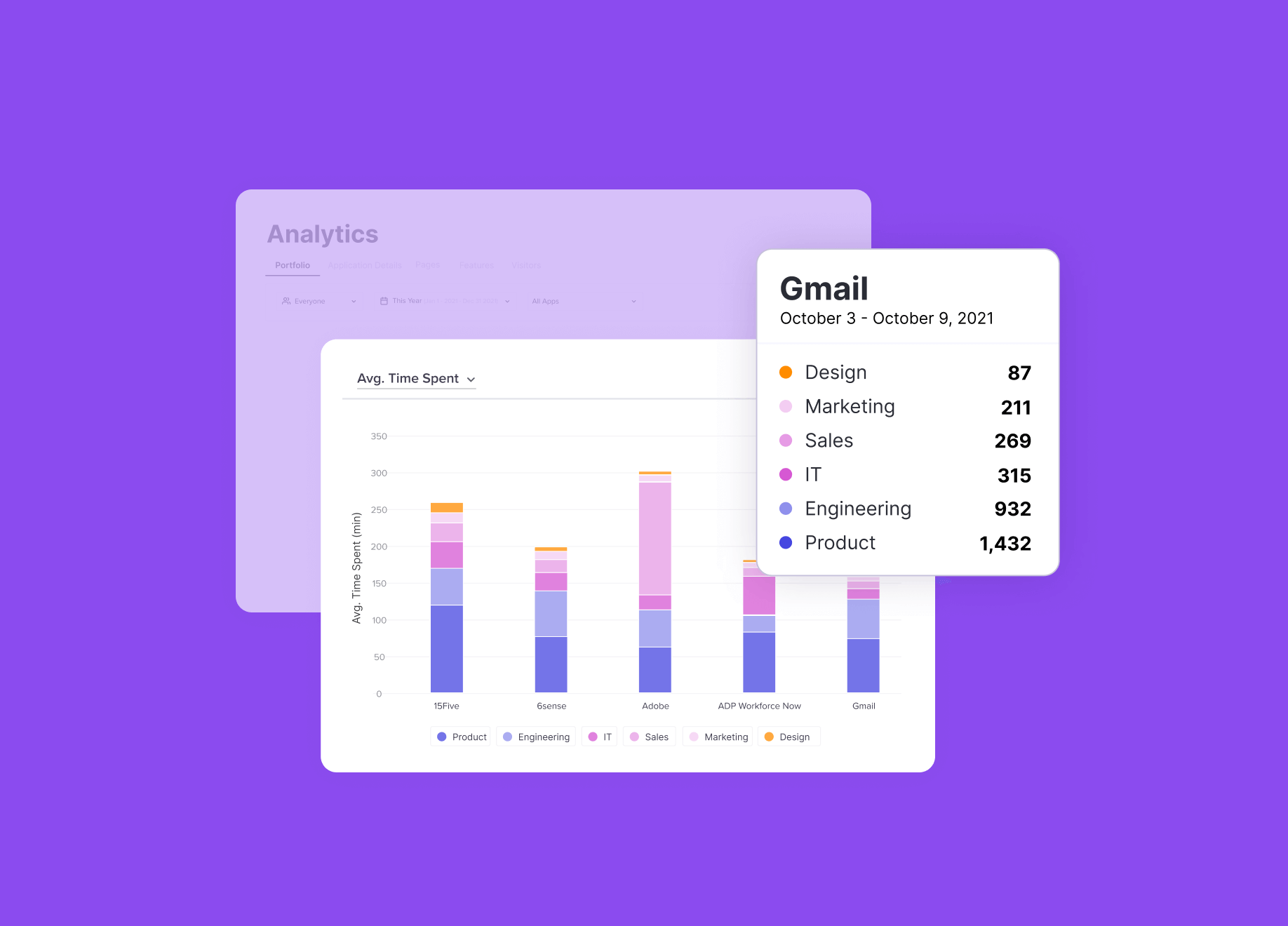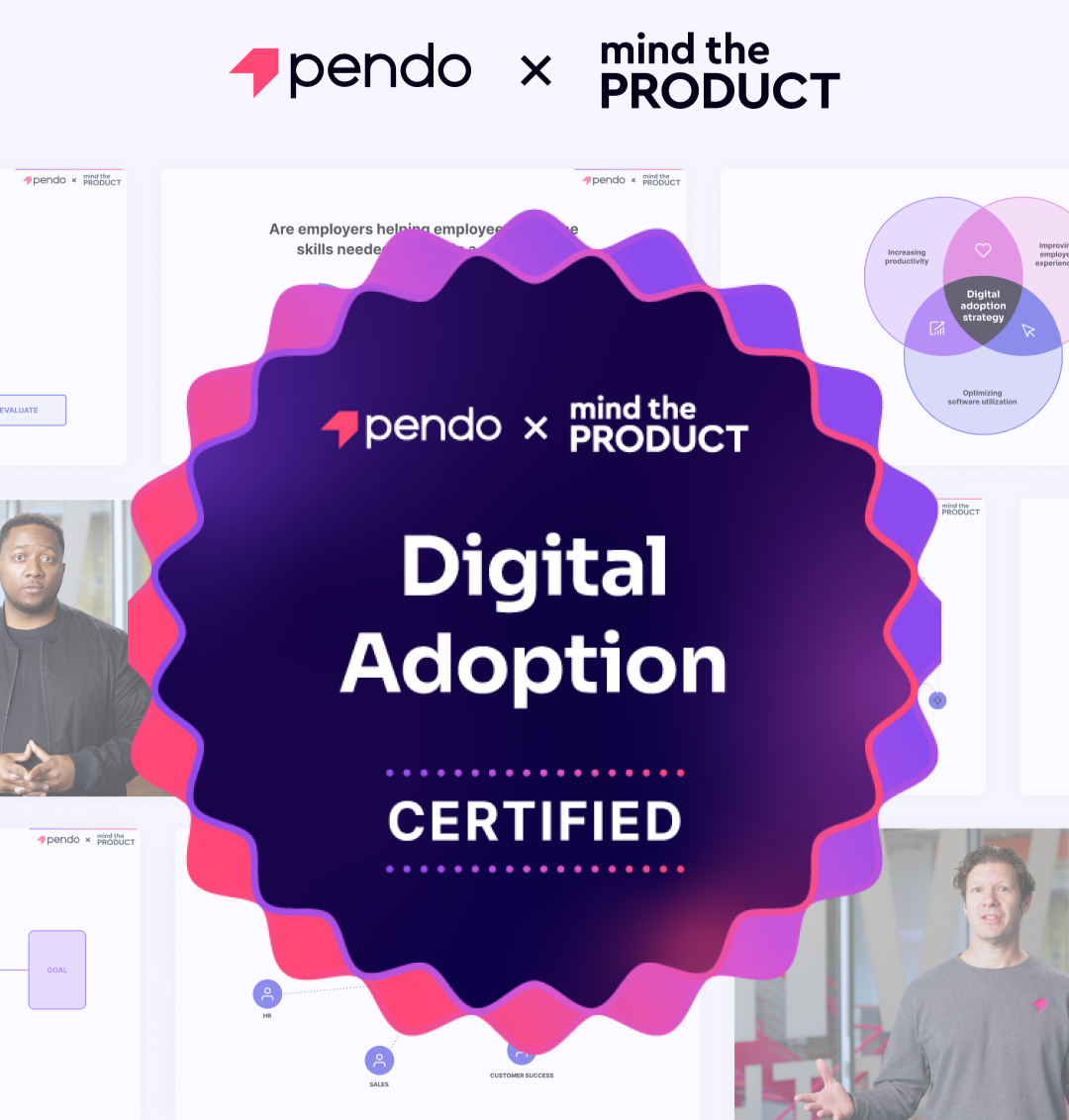Inhaltsverzeichnis
Was ist Produktakzeptanz?
Die Produktakzeptanz ist der Prozess der Benutzeraktivierung (oder Kundenaktivierung) für eine webbasierte oder mobile Anwendung. Mithilfe der Akzeptanz können Produktteams feststellen, ob das Produkt gemessen an der Interaktion mit dem Produkt den beabsichtigten Nutzen erbringt.Grundsätzlich ist die Akzeptanz ein führender Indikator für ein gesundes Softwareprodukt (und Unternehmen).
Warum ist Produktakzeptanz wichtig?
Mit dem Übergang zur abonnementbasierten Softwarelizenzierung ist die Produktinteraktion – und insbesondere die Produktakzeptanz – viel wichtiger geworden als in der On-Premise-Ära. Produktmanager konzentrieren sich seit jeher auf die Verbesserung des Kundenerlebnisses. Das frühzeitige Fördern der Aktivierung ist jedoch in SaaS wichtiger denn je, da monatlich Softwareprodukte gekauft werden.
Metriken zur Produktakzeptanz
Die Produktakzeptanz kann anhand dieser Kennzahlen gemessen werden:
- Stickiness: „Stickiness“ bedeutet hier die Zahl der Nutzer, die sich eine Mindestanzahl von Malen in einem Produkt anmelden, ausgedrückt als Anzahl in einem Zeitraum.
- Funktionsakzeptanz: Die Funktionsakzeptanz misst, wie viele Benutzer zu einem bestimmten Zeitpunkt oder im Laufe der Zeit mit den spezifischen Features Ihres Produkts interagieren.
- Wachstum: Das Wachstum misst den Nettoeffekt Ihrer Bemühungen um die Benutzerakquise und -bindung. Mit anderen Worten: Gewinnen Sie schneller neue Benutzer hinzu, als Sie bestehende verlieren? Wachstum kann durch das Hinzufügen neuer Konten oder die Steigerung der Nutzung bestehender Konten erreicht werden. Es wird ausgedrückt als die Summe der neuen und wiedergewonnenen Konten oder Besucher geteilt durch die gelöschten Konten oder Besucher.
- Monatlich aktive Benutzer (MAU): Die durchschnittliche Anzahl der Benutzer, die Ihr Produkt jeden Monat besuchen.
- Wöchentlich aktive Benutzer (WAU): Die durchschnittliche Anzahl der Benutzer, die Ihr Produkt jede Woche besuchen.
- Täglich aktive Benutzer (DAU): Die durchschnittliche Anzahl eindeutiger Besucher Ihres Produkts pro Tag.
Wie lässt sich die Produktakzeptanz messen?
Sie können die Produktakzeptanz als Quote im Verhältnis zu neuen Benutzeranmeldungen für einen bestimmten Zeitraum messen.
Zum Beispiel:
Monatliche Produktakzeptanzrate (%) = [neue MAU/monatliche Anmeldungen] * 100.
Die Art und Weise, wie Sie Ihre Produktakzeptanz messen, hängt weitgehend davon ab, was es bedeutet, ein aktiver Benutzer Ihres Produkts zu sein. Wenn es sich bei Ihrer Software um eine Software handelt, auf die Kunden jeden Tag zugreifen sollten, ist eine DAU-Metrik möglicherweise am sinnvollsten. Wenn es sich bei Ihrem Produkt um ein B2C-Produkt handelt, sollten Sie besser die Häufigkeit der Konversionen (z. B Einkäufe) oder die in der App verbrachte Zeit messen.
So steigern Sie die Produktakzeptanz
Die Steigerung der Produktakzeptanz hängt von der Verbesserung Ihres Produkts ab. Je besser die Erfahrung, die Sie schaffen, desto wahrscheinlicher ist es, dass die Benutzer Ihr Produkt weiterhin nutzen. Neben einer durchdachten Onboarding-Strategie für die App gibt es noch einige andere wichtige Möglichkeiten, um die Produktakzeptanz zu verbessern:
- Nutzen Sie Produktnutzungsdaten: Was man nicht misst, kann man nicht verbessern. Um die Produktakzeptanz zu bewerten, sollten Sie sich auf Daten zur Produktnutzung stützen, um zu verstehen, wie sich die Benutzer engagieren, wo sie hängenbleiben und welche Möglichkeiten es gibt, ihr Erlebnis mit Ihrer Anwendung zu verbessern. Es gibt eine Vielzahl von Kennzahlen zur Produktakzeptanz, aber wir empfehlen, die Akzeptanz von Funktionen, die „Stickiness“ und das Wachstum zu verfolgen (aus denen sich auch Ihr Product Engagement Score zusammensetzt).
- Kommunizieren Sie mit Benutzern in der App: Der beste Weg, das Bewusstsein für die wichtigsten Funktionen zu schärfen und eine bessere Nutzung Ihres Produkts zu fördern, ist durch In-App-Messaging. Indem Sie mit den Nutzern in der App kommunizieren, können Sie sie genau dann erreichen, wenn diese Informationen am relevantesten sind, egal ob es sich dabei um die Aufklärung der Nutzer, die Ankündigung von Funktionen, das Onboarding oder etwas anderes handelt.
- Bringen Sie Support in das Produkt: Die Unterbringung von Support-Materialien in Ihrem Produkt ermutigt die Benutzer, sich selbst zu helfen, wenn sie nicht weiterkommen oder eine Frage haben, und trägt dazu bei, die Wahrscheinlichkeit zu minimieren, dass sie aufgeben und die Produktnutzung komplett aufgeben. Auch wenn es normalerweise nicht das erste ist, was einem in den Sinn kommt, ist es eine wichtige Taktik, um die Akzeptanz eines Produkts zu fördern.
- Nutzerfeedback einholen: Erfassen Sie neben quantitativen Nutzungsdaten auch qualitatives Feedback von Ihren Benutzern, um ihre Erfahrungen mit Ihrem Produkt und alles, was ihrer Meinung nach fehlt, besser zu verstehen. Verwenden Sie In-App-Umfragen, um Benutzer zu fragen, was sie von einer bestimmten Funktion halten, oder um bestimmte Segmente Ihrer Benutzerbasis gezielt zu erreichen.
Wie wirkt sich das Onboarding auf den Produktakzeptanzprozess aus?
Der Zeitraum nach der Anmeldung ist der wichtigste Zeitraum in einem Produktlebenszyklus – nach dem ersten Tag fallen die Produktakzeptanzraten drastisch ab. Das Onboarding neuer Nutzer ab dem ersten Öffnen der Web- oder mobilen App ist daher von entscheidender Bedeutung. Allerdings findet das Onboarding statt, egal ob das Erlebnis gelenkt wird oder nicht. Unternehmen, die sich auf das Onboarding-Erlebnis konzentrieren, können ihre Nutzer viel schneller zu kompetenten Anwendern machen und die Produktakzeptanz-Kennzahlen wie aktive Nutzung und Bindung steigern.
Die Zunahme von SaaS-Anwendungen hat die Umstellungskosten der Kunden drastisch reduziert. Diese sind viel eher geneigt abzuwandern, wenn sie nicht schnell den Nutzen realisieren. Produktakzeptanz hängt von einem Onboarding-Flow ab, der:
- schnell erklärt, wie das Produkt funktioniert und was seine Anwendungsfälle sind
- die Vorteile und Differenzierung des Produkts vermittelt
- die wichtigsten Funktionen hervorhebt und die Nutzer dahin lenkt
- Anreize, die Nutzer anregen, immer wieder zu dem Produkt zurückzukehren
Was ist die Produktakzeptanzkurve?
Die Produktakzeptanzkurve ist eine Möglichkeit der Betrachtung, wie (und wann) verschiedene Benutzertypen Ihr Produkt annehmen. Wie der Name schon sagt, hat sie die Form einer Glockenkurve und umfasst fünf Arten von Softwarebenutzern: Innovatoren, Early Adopters, Early Majority, Late Majority und Laggards.
Die Nutzerbasis eines Produkts ist vielfältig – sie umfasst unterschiedliche Benutzertypen, Anwendungsfälle und technische Kenntnisstände.Die Auswirkung der Faktoren auf die Akzeptanzwahrscheinlichkeit der Benutzer sowie auf Ihre Akzeptanzstrategien und -taktiken muss dabei beachtet werden. Hier ist ein kurzer Überblick über die Produktakzeptanzkurve:
- Innovatoren: Das sind die allerersten Nutzer, die Ihr Produkt nutzen und kaufen. Sie sind meist technikbegeistert (und nutzen bereits viele andere Softwareprodukte) und möchten das neueste Tool in Ihrer Branche kennenlernen. Auch wenn diese Nutzer am seltensten Ihre höchste Preisklasse kaufen werden, sind sie einige der ersten, die Ihre Lösung nutzen, und somit eine hervorragende Quelle für Feedback. Profi-Tipp: Erheben Sie mit In-App-Anleitungen Feedback von Innovatoren, während diese aktiv mit Ihrem Produkt interagieren.
- Early Adopters: Diese Gruppe ähnelt den Innovatoren in ihrem Interesse, Neues auszuprobieren, hat jedoch mit größerer Wahrscheinlichkeit einen konkreten Bedarf an Ihrem Produkt. Early Adopters sind auch bei der Gestaltung Ihrer Markteinführungsstrategie hilfreich, denn Ihr Produkt sollte die Probleme dieser Nutzergruppe lösen.
- Early Majority: Die Gruppe der Early Majority möchte ein Produkt, das ihre Bedürfnisse direkt erfüllt. Im Vergleich zu den Early Adopters tolerieren sie Produktfehler und -probleme seltener. Daher muss Ihr Produkt unbedingt stabil sein und seinen Zweck zuverlässig erfüllen. Ausgehend von der Produktakzeptanzkurve stammt etwa ein Drittel Ihrer Benutzer aus dieser Gruppe.
- Late Majority: Diese Benutzer wissen wahrscheinlich, dass es Ihr Produkt gibt, haben sich aber noch nicht dazu entschlossen, es zu verwenden oder zu kaufen. Um die Akzeptanz in dieser Gruppe zu fördern, müssen Sie sie auf eine Weise über Ihr Produkt aufklären, die ihre bisherigen Vorbehalte ausräumt. Dabei kann es besonders wirkungsvoll sein, ihnen zu vermitteln, dass Ihr Produkts ihnen einen Wettbewerbsvorteil auf dem Markt verschafft.
- Laggards: Laggards sind die letzten Personen, die Ihr Produkt annehmen, da sie dessen Wert skeptisch gegenüberstehen (oder standen). Da diese Benutzer einen relativ kleinen Teil Ihrer Benutzerschaft ausmachen, ist der direkte Verkauf an sie nicht so wichtig. Das Erreichen dieser Phase könnte sogar ein Zeichen dafür sein, dass Ihr Produktangebot innovativer gestaltet oder überarbeitet werden sollte.
Welche Faktoren beeinflussen die Produktakzeptanzrate?
Es gibt mehrere Faktoren, die Ihre Produktakzeptanzrate beeinflussen. Im Grunde genommen müssen Benutzer ein klares Verständnis für den Wert Ihres Produkts haben und verstehen, was seine wichtigsten Funktionen sind und wie sie es effektiv nutzen können. Hier kommt das Onboarding ins Spiel. Ihr Onboarding-Erlebnis muss den Benutzern helfen, sich mit dem Produkt so vertraut zu machen, dass sie beginnen, es für den beabsichtigten Zweck zu verwenden – und es zu einem Teil ihres täglichen Lebens machen. Durch den Einsatz von In-App-Onboarding können Teams neuen Benutzern mit Anleitungen, Tool-Tipps und anderen Arten von In-App-Messaging helfen. Noch besser: Mit dieser Strategie können Sie Onboarding-Abläufe für verschiedene Benutzertypen (z. B. Benutzer mit unterschiedlichen Rollen) personalisieren und sicherstellen, dass die Inhalte für die spezifischen Bedürfnisse der Benutzer relevant sind.
Über das Onboarding hinaus hängt die Akzeptanz auch davon ab, dass Ihr Produkt über eine intuitive Benutzeroberfläche (UI) verfügt, die das Benutzererlebnis nicht beeinträchtigt. Um Schwachstellen zu identifizieren oder herauszufinden, wo Benutzer hängenbleiben, können Teams Produktanalysen nutzen. Mit ihnen erfahren sie, wie sich Benutzer durch das Produkt bewegen, welche Schlüsselfunktionen nicht verwendet werden (falls es solche gibt) und ob es Abbruchpunkte gibt, die untersucht werden sollten. Nutzen Sie dann In-App-Anleitungen, um Benutzer zu und durch Arbeitsabläufe zu führen und kontextbezogene Hilfe bei der Navigation durch das Produkt bereitzustellen.
Wo kann ich mehr über die Produktakzeptanz erfahren?
Für alle, die sich etwas eingehender mit Produkt- und Funktionsakzeptanz befassen möchten, gibt es eine Reihe von Büchern zu diesem Thema. Dazu zählen „Crossing the Chasm“ von Geoffrey A. Moore, „The Innovator's Dilemma“ von Clayton M. Christensen und „The Lean Startup“ von Eric Ries. Pendo hat auch Informationen zum Onboarding von Benutzern sowie zur Steigerung des ROI durch Produktinvestitionen veröffentlicht.
Dies könnte Sie auch interessieren

So erstellen Sie ein Pendo-Dashboard, mit dem Sie die Produkt- oder Funktionsakzeptanz messen



